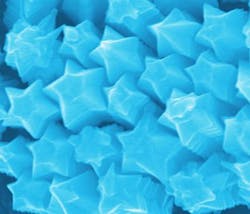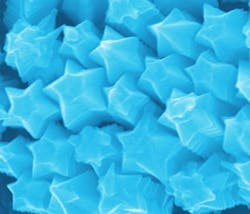'Starfruit' nanorods could boost SERS in medical imaging
Starfruit-shaped gold nanorods synthesized by researchers at Rice University (Houston, TX) could boost medical imaging and chemical sensing applications that depend on surface-enhanced Raman spectroscopy (SERS). The researchersâassociate professor of chemistry Eugene Zubarev and Leonid Vigderman, a graduate student in his lab at the university's BioScience Research Collaborativeâfound their particles returned signals 25 times stronger than similar nanorods with smooth surfaces, enabling detection of very small amounts of DNA and biomarkers for particular diseases.
Zubarev and Vigderman grew batches of the star-shaped rods in a chemical bath. They started with seed particles of highly purified gold nanorods with pentagonal cross-sections developed by Zubarev's lab in 2008 and added them to a mixture of silver nitrate, ascorbic acid, and gold chloride.
Over 24 hours, the particles plumped up to 550 nm long and 55 nm wide, many with pointy ends. The particles take on ridges along their lengths; photographed tip-down with an electron microscope, they look like stacks of star-shaped pillows.
When Zubarev and Vigderman added a common surfactant, cetyltrimethylammonium bromide (CTAB), to the mix, the bromide combined with the silver ions to produce an insoluble salt. The researchers think that a thin film of the silver bromide forms on the side faces of rods and partially blocks them, in turn slowing down the deposition of gold on those flat surfaces and allowing the nanorods to gather more gold at the pentagon's points, where they grew into the ridges that gave the rods their star-like cross-section.
The researchers tried replacing silver with other metal ions such as copper, mercury, iron, and nickel. All produced relatively smooth nanorods. "Unlike silver, none of these four metals form insoluble bromides, and that may explain why the amplification is highly uniform and leads to particles with smooth surfaces," says Zubarev.
The researchers also grew longer nanowires that, along with their optical advantages, may have unique electronic properties. Ongoing experiments with Stephan Link, an assistant professor of chemistry and chemical and biomolecular engineering, will help characterize the starfruit nanowires' ability to transmit a plasmonic signal. "If we can modify the surface roughness such that biological molecules of interest will adsorb selectively on the surface of our rugged nanorods, then we can start looking at very low concentrations of DNA or cancer biomarkers. There are many cancers where the diagnostics depend on the lowest concentration of the biomarker that can be detected," says Zubarev. The nanowires also could be useful for waveguides and other optoelectronic devices.
The research appears in the American Chemical Society journal Langmuir; for more information, please visit http://pubs.acs.org/doi/abs/10.1021/la300218z.
-----
Follow us on Twitter, 'like' us on Facebook, and join our group on LinkedIn
Follow OptoIQ on your iPhone; download the free app here.
Subscribe now to BioOptics World magazine; it's free!

